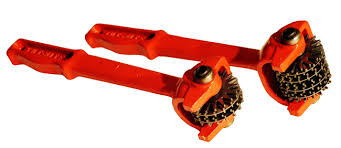I have a Dewalt 756, a 6" bench grinder with 1/2" arbor, . When I got it I put in two AO wheels, Norton 36 grit and 80 grit, 1" hole, 3/4" wide wheels with plastic bushings. I put it on a Wen pedestal, and mounted the pedestal on a piece of 1/2" plywood. The drill itself is mounted on 1/2" ply to raise it a bit and to give me more space around it. I did not, as has been suggested, fill the pedestal with sand or rocks, but hold it still with my foot when it's running.
The drill's vibration level is pretty high, and it has twice shaken off a bolt holding the grinder rest in place. When I shut it down, the vibration develops a pounding harmonic.
Today a friend, who has serious skills in just about everything except machining came over to help me install a shelf over the lathe and to replace the lathe's nearly shot drum switch with a newer one I got hold of. We got the shelf up, but when I had to grind down a couple of the screws he needed, he immediately said that the grinder is making far too much noise, far too much vibration. My thought was that it was not on a bench and the pedestal was too light; he was certain that was not the problem. At first we thought the shaft might have been bent. We pulled both wheels; there is no vibration with the wheels off, it hums, smooth and perfectly straight. We reinstalled the wheels, wrenched them in tight, and the vibration did not go away. And, it still looks as if it's not running completely round. His view is that the plastic bushings have too much play and the runout is causing the vibration. I searched online for a replacement wheel but everything I saw has the same plastic bushings. Should I have gotten a grinding wheel with a 1/2" hole to match the arbor? It seems to me that they sell thousands of them with the bushings, they can't all be bad ideas. Do I have bad bushings? The wrong wheels? What am I missing here?
Many thanks, as always,
Tim
The drill's vibration level is pretty high, and it has twice shaken off a bolt holding the grinder rest in place. When I shut it down, the vibration develops a pounding harmonic.
Today a friend, who has serious skills in just about everything except machining came over to help me install a shelf over the lathe and to replace the lathe's nearly shot drum switch with a newer one I got hold of. We got the shelf up, but when I had to grind down a couple of the screws he needed, he immediately said that the grinder is making far too much noise, far too much vibration. My thought was that it was not on a bench and the pedestal was too light; he was certain that was not the problem. At first we thought the shaft might have been bent. We pulled both wheels; there is no vibration with the wheels off, it hums, smooth and perfectly straight. We reinstalled the wheels, wrenched them in tight, and the vibration did not go away. And, it still looks as if it's not running completely round. His view is that the plastic bushings have too much play and the runout is causing the vibration. I searched online for a replacement wheel but everything I saw has the same plastic bushings. Should I have gotten a grinding wheel with a 1/2" hole to match the arbor? It seems to me that they sell thousands of them with the bushings, they can't all be bad ideas. Do I have bad bushings? The wrong wheels? What am I missing here?
Many thanks, as always,
Tim


